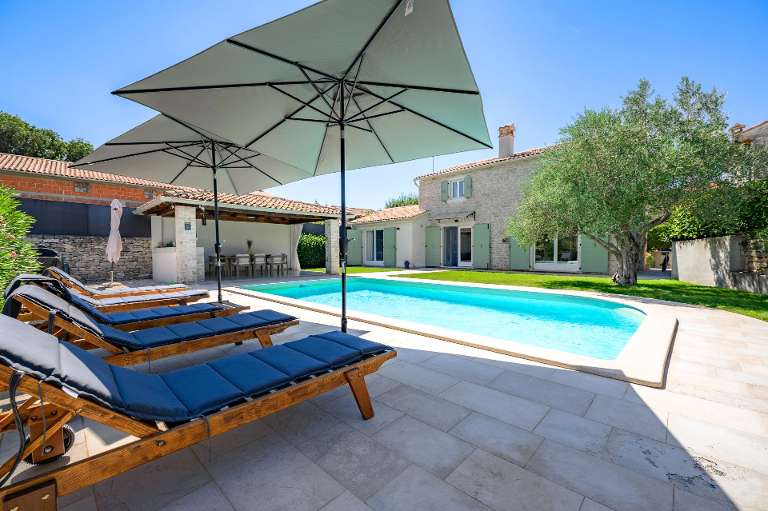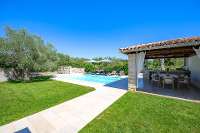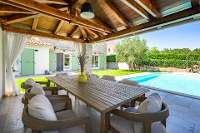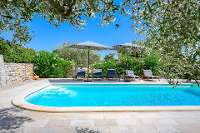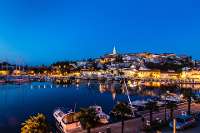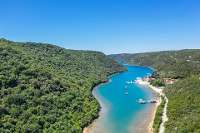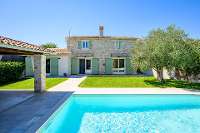Great Things to Do Near Villa Lovrec
Cape Kamenjak
Cape Kamenjak is a wonderful nature park located on the Premantura peninsula on the southern tip of Istria. With an unusual landscape, miles of rugged coastline and beaches to enjoy, coves and caves to explore, and a quirky ‘safari bar' it is a great day out for adults and children alike.
Aquacolors - the largest waterpark in Croatia
Spend the day at a waterpark: Aquacolors is situated just south of Porec, on the road towards Funtana and Vrsar. Expect the usual selection of slides and pools as well as certain other sporting activities and fast(ish) food catering. A half day ticket is available for arrivals in the afternoon. The other waterpark, by the way, is Istralandia, just south of Novigrad.
Cycling and walking along the Parenzana
The Parenzana is a narrow gauge railway which ran from Trieste to Porec. Opened in 1902, its track covered a distance of 123km. Daily, the small train would follow the route carrying passengers and a cargo of, variously, salt from the salt pans of today’s Slovenian coast, olive oil from Motovun, Buje and the surrounding area, Istrian stone and other items such as wine, fruit and vegetables. It sadly closed in 1935 but remained affectionately in the hearts of the Istrian people. So much so that parts of it have reopened as a cycling and hiking track and a small motorised passenger train now runs along its route, a great way to see parts of northern Istria’s spectacular landscapes.
Funtana and Fažana
Visit Funtana, a coastal village between Vrsar and Porec. The Istrian coast is said to be the most indented here offering numerous coves, inlets, beaches and pine and oak groves. A number of fresh water springs or fountains, hence the derivation of the name Funtana, and this has secured the prosperity of the village over the centuries.
Fazana is a colourful town, its quayside backed with pastel-coloured Italianate buildings and many waterfront cafes, bars and restaurants. If you stop for a snack you must try pilchards, emblematic of the town. Try them cold in a marinade of oil, vinegar, water, parsley, rosemary and pepper – the Istrian way!
Sveti Lovrec
The nearest town/village to Villa Lovrec, with a mini market, bakery, cafe, and pizzeria. This attractive, walled little town was the headquarters of Venice’s military command in Istria during the Middle Ages. See the 11th century church of Sv. Martin and view the museum in the 15th century loggia which displays sculptures from the monastery of Sv. Mihovil in the Limski Kanal.
Get Your Kicks... On Route 66!
For a beautiful scenic drive, take the road no. 66 north east which hugs the coastline of the Kvarner Riviera. Start from Barban, passing through Raša, Labin, Plomin, Mošcenicka Draga, Lovran, Opatija and round to Rijeka. Any of these places would make a good stop for a drink or a meal. Return to your house taking the inland route via the Ucka Tunnel (toll payable). You will need to allow at least half a day for this.
Vrsar and its Archipelago
Vrsar, at the northern mouth of the Limski Kanal is often overlooked because of the larger towns of Rovinj to the south and Porec to the north. The old town however, atop a hill, is a beautifully kept architectural gem with a number of brightly painted buildings chaperoning the citadel (kaštel), once the summer residence of Porec bishops. Look for the relief of a lion on the stone slab above the old town gate.
The coast around Vrsar is one of the most indented along the Istrian coastline. There are 18 tiny islands and islets to explore - there are a number of companies that offer boat tours including trips for dolphin watching.
Take a Trip to the Brijuni Islands
Once Tito’s holiday home and the meeting place for the international jet set it is now the only national park in Istria. Principal of the 14 islands, Veliki Brijuni, is the one to visit because of the diversity of its interests: see wildlife including deer and peacocks roam wild in beautiful natural parkland; Roman ruins; a safari park; beaches and traces of dinosaur footprints! You need to allow at least half a day for this excursion which involves taking a ferry from Fažana. Take a picnic with you or enjoy a meal in one of the island’s cafes.
Spot the beehive-shaped Kažun
Driving around Istria, look for the kažun, a round beehive-shaped field hut built using the dry-stone technique, without any mortar or concrete. The material for this was usually collected by cleaning fields of excess pieces of stone. Farmers and peasants used them for shelter and for guarding vineyards or olive groves as well as for storage of agricultural implements. The kažun has become emblematic of traditional Istria and can be found all over the region these days, however they were traditionally prevalent in the south and west.
Night Skies and Stargazing
Visit the Višnjan Observatory. The original observatory can be found in the town itself, whilst the new observatory is just three kilometers north of Višnjan, on Tičan hill. More than 100 minor planets, two comets and over 1700 asteroids have been discovered here. During the summer months (July, August, September) the public can take part in Astro Nights (English speaking), two hours of observations, children's workshops and a tour of the new observatory.
Oysters and Mussels in the Limski Kanal
Pay a visit to nearby Lim Fjord, a spectacular protected landscape and special marine reserve situated between Rovinj and Vrsar. This long, narrow inlet is bordered by wooded, canyon-like cliffs rising up to 150m above sea level. It is said that one flank of this canal is populated by deciduous trees, the other by evergreens. A couple of restaurants are situated on the water front.
Platforms in the fjord betray the farming of oysters, mussels and fish such as bream and sea bass, encouraged by underwater freshwater springs which render the water partially brackish.
The Batanas of Rovinj
The spacious quaysides in Rovinj are the perfect venue to sit and unwind at one of the many terraced ice cream parlours or cafeterias. Sip a cappuccino and do some people-watching! Often street artists such as choirs, bands, jugglers etc can be seen here, usually performing close to the fountain. Whilst in Rovinj, look for the batanas, traditional flat-bottomed, square-sterned, brightly painted wooden boats which have been used for centuries by the local fishermen.
Spend a day or two abroad
Istria's northern border is with Slovenia. From Buje in northern Istria, either take the road into Slovenia via the border point at Kastell or cross the border at Plovanija-Secovlje. From here you might like to explore some of Slovenia's pretty coastal towns such as Koper, Izola, Piran or Portoroz, all within 30 minutes of the border.
Or spend the day in Venice - take the hydrofoil service from Rovinj, Porec or Pula to this unique city.
You'll need your passports and if you picked your hire car up in Croatia, you'll need to check with your supplier that you can cross the border into Slovenia with it.
Pula
The capital city, Pula is set in the valley of seven hills and offers fabulous Adriatic views. It is a delight to walk around with narrow cobbled streets, magnificent Roman buildings and the Pula Arena, an enormous, spectacular amphitheatre, built to host 20,000 spectators - it is the only remaining Roman amphitheatre in the world with a complete circle wall.
Frescoes at Beram
Many of Istria’s churches and chapels house frescoes but the largest and best-preserved, dating from the fifteenth century, are found in the church of sv Marije (St Mary) at Škrijinah, near to the village of Beram and just to the north east of Pazin. It is signposted from the Pazin-Porec road, no. 48.
Picturesque Porec
This charming coastal town has plenty to offer for a morning stroll or even a whole day full of sightseeing and exploration. Have a coffee or lunch at one of the elegant cafes, bars or restaurants lining the seafront and drink in the glorious view of the blue Adriatic sea, and gazing out towards the island of Sveti Nikola. Whilst in Porec, visit the open air market on the edge of the town and pick up some local produce for your dinner back at the villa by the pool.
The Leaning Tower of Zavrsje
You'll have noticed all the Italian influences in the place names, the architecture and the food, well make a visit to nearby Zavrasje which has its own leaning tower! The belfry here, 22 metres high, has an inclination of 40 centimetres. Take your camera, it's the most beautiful little village!
Have a beach day
You are spoilt for choice when it comes to beaches. The Istrian coastline boasts a huge range of beaches from the top, close to the Slovenia border to the bottom near Pula and then all round the coast from Pula to Rijeka. Many have Blue Flag status, most are rocky and pebbly, a few are sandy. There are a lot to choose from around Rovinj, Vrsar and Porec – head for Zlatni Rat Beach, Lone Bay Beach, Materada Beach.
Go To Hell!
More politely, visit Pazin Castle, a 16th century structure standing on the remains of its 10th century predecessor. It overhangs a gorge into which the river Pazincica disappears, supposedly the inspiration for Dante’s description of the Gateway to Hell in his Inferno as well as a major scene from Jules Verne’s 1885 novel Mathias Sandorf.
